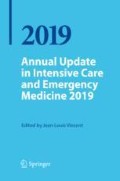Abstract
The mixed venous oxygen saturation (SvO2) has been used to assess the adequacy of oxygen delivery (DO2) to oxygen consumption (VO2). Since central venous catheters (CVCs) are now more often inserted than pulmonary artery catheters (PAC) in critically ill patients, central venous oxygen saturation (ScvO2) has been proposed as a substitute for SvO2. In 2001, Rivers et al. proposed a step-by-step strategy called early goal-directed therapy (EGDT) that aimed at normalizing the ScvO2 within the first 6 h of resuscitation of patients with severe sepsis or septic shock [1]. A single-center randomized controlled trial (RCT) showed that application of EGDT significantly decreased mortality in comparison with a control group, in which ScvO2 was not used [1]. Following the publication by Rivers et al. [1], EGDT was endorsed by the Surviving Sepsis Campaign (SSC) in 2004 [2]. More recently, three multicenter RCTs (ProCESS [3], ARISE [4] and ProMISe [5]) compared EGDT (using ScvO2) to standard care (with no use of ScvO2). In none of these trials did EGDT show any benefit in terms of outcome, as confirmed by a meta-analysis [6]. Differences between the trials (design/study population/management of the control group/general management of patients with sepsis) may have contributed to the divergent results of these trials [7]. Nevertheless, the SSC experts removed ScvO2 (and SvO2) from the recommendations of the most recent version of the SSC guidelines [8]. While targeting specific predefined values in all patients may be questioned, it is probably unwise to neglect the potential interest of measuring SvO2/ScvO2 in patients with sepsis. In this chapter, we discuss why there is still a place for the measurement of SvO2 or ScvO2 in patients with sepsis.
Access this chapter
Tax calculation will be finalised at checkout
Purchases are for personal use only
References
Rivers E, Nguyen B, Havstad S, et al. Early goal-directed therapy in the treatment of severe sepsis and septic shock. N Engl J Med. 2001;345:1368–77.
Dellinger RP, Carlet JM, Masur H, et al. Surviving Sepsis Campaign guidelines for management of severe sepsis and septic shock. Crit Care Med. 2004;32:858–73.
Yealy DM, Kellum JA, Huang DT, et al. A randomized trial of protocol-based care for early septic shock. N Engl J Med. 2014;370:1683–93.
Peake SL, Delaney A, Bailey M, et al. Goal-directed resuscitation for patients with early septic shock. N Engl J Med. 2014;371:1496–506.
Mouncey PR, Osborn TM, Power GS, et al. Trial of early, goal-directed resuscitation for septic shock. N Engl J Med. 2015;372:1301–11.
Rowan KM, Angus DC, Bailey M, et al. Early, goal-directed therapy for septic shock - a patient-level meta-analysis. N Engl J Med. 2017;376:2223–34.
Rhodes A, Evans LE, Alhazzani W, et al. Surviving sepsis campaign: international guidelines for management of sepsis and septic shock: 2016. Intensive Care Med. 2017;43:304–77.
De Backer D, Vincent JL. Early goal-directed therapy: do we have a definitive answer? Intensive Care Med. 2016;42:1048–50.
Kasnitz P, Druger GL, Yorra F, Simmons DH. Mixed venous oxygen tension and hyperlactatemia. JAMA. 1976;236:570–4.
Schlichtig R, Cowden WL, Chaitman BR. Tolerance of unusually low mixed venous oxygen saturation. Adaptations in the chronic low cardiac output syndrome. Am J Med. 1986;80:813–8.
Vincent JL, De Backer D. Circulatory shock. N Engl J Med. 2013;369:1726–34.
Chawla LS, Zia H, Gutierrez G, Katz NM, Seneff MG, Shah M. Lack of equivalence between central and mixed venous oxygen saturation. Chest. 2004;126:1891–6.
Reinhart K, Kuhn HJ, Hartog C, Bredle DL. Continuous central venous and pulmonary artery oxygen saturation monitoring in the critically ill. Intensive Care Med. 2004;30:1572–8.
Dueck MH, Klimek M, Appenrodt S, Weigand C, Boerner U. Trends but not individual values of central venous oxygen saturation agree with mixed venous oxygen saturation during varying hemodynamic conditions. Anesthesiology. 2005;103:249–57.
Varpula M, Karlsson S, Ruokonen E, Pettilä V. Mixed venous oxygen saturation cannot be estimated by central venous oxygen saturation in septic shock. Intensive Care Med. 2006;32:1336–43.
Gutierrez G, Comignani P, Huespe L, et al. Central venous to mixed venous blood oxygen and lactate gradients are associated with outcome in critically ill patients. Intensive Care Med. 2008;34:1662–8.
van Beest PA, van Ingen J, Boerma EC, et al. No agreement of mixed venous and central venous saturation in sepsis, independent of sepsis origin. Crit Care. 2010;14:R219.
De Backer D, Creteur J, Noordally O, Smail N, Gulbis B, Vincent JL. Does hepato-splanchnic VO2/DO2 dependency exist in critically ill septic patients? Am J Respir Crit Care Med. 1998;157:1219–25.
Boulain T, Garot D, Vignon P, et al. Prevalence of low central venous oxygen saturation in the first hours of intensive care unit admission and associated mortality in septic shock patients: a prospective multicentre study. Crit Care. 2014;18:609.
Pope JV, Jones AE, Gaieski DF, Arnold RC, Trzeciak S, Shapiro NI. Multi-center study of central venous oxygen saturation (ScvO2) as a predictor of mortality in patients with sepsis. Ann Emerg Med. 2010;55:40–6.
Textoris J, Fouché L, Wiramus S, et al. High central venous oxygen saturation in the latter stages of septic shock is associated with increased mortality. Crit Care. 2011;15:R176.
Monnet X, Julien F, Ait-Hamou N, et al. Lactate and veno-arterial carbon dioxide difference/arterial-venous oxygen difference ratio, but not central venous oxygen saturation, predict increase in oxygen consumption in fluid responders. Crit Care Med. 2013;41:1412–20.
Cecconi M, De Backer D, Antonelli M, et al. Consensus on circulatory shock and hemodynamic monitoring. Task force of the European Society of Intensive Care Medicine. Intensive Care Med. 2014;40:1795–815.
Teboul JL, Saugel B, Cecconi M, et al. Less invasive hemodynamic monitoring in critically ill patients. Intensive Care Med. 2016;42:1350–9.
Author information
Authors and Affiliations
Corresponding author
Editor information
Editors and Affiliations
Rights and permissions
Copyright information
© 2019 Springer Nature Switzerland AG
About this chapter
Cite this chapter
Teboul, JL., Monnet, X., De Backer, D. (2019). Should We Abandon Measuring SvO2 or ScvO2 in Patients with Sepsis?. In: Vincent, JL. (eds) Annual Update in Intensive Care and Emergency Medicine 2019. Annual Update in Intensive Care and Emergency Medicine. Springer, Cham. https://doi.org/10.1007/978-3-030-06067-1_17
Download citation
DOI: https://doi.org/10.1007/978-3-030-06067-1_17
Published:
Publisher Name: Springer, Cham
Print ISBN: 978-3-030-06066-4
Online ISBN: 978-3-030-06067-1
eBook Packages: MedicineMedicine (R0)

